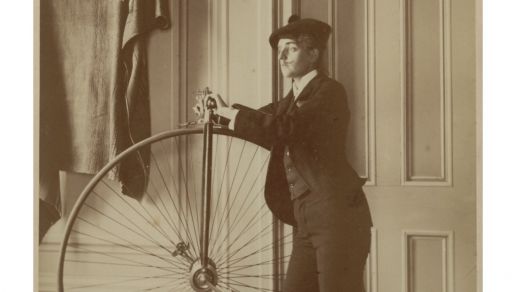Josiah McElheny: The Light Club of Vizcaya: A Women’s Picture
Cara Despain

Josiah McElheny, The Light Club of Vizcaya: A Women’s Picture, 2012. Photo courtesy Vizcaya Museum and Gardens.
November 19, 2012 – March 18, 2013
Given Josiah McElheny’s interest in the intersection of utopian ideals and architecture, design, and modernity, it seems apt to mine the archives of Miami’s treasured Vizcaya Museum and Gardens. McElheny’s commissioned project proposes an imagined subtext to Vizcaya’s history based on the obscure novella The Light Club of Batavia (1912) by Paul Scheerbart, a German author who advocated for a utopia in which all buildings are constructed of translucent glass. McElheny’s story postulates that the garden mound conceals a secret spa made entirely of colored glass where those of an elite club could bathe in colored light.
Though steeped in similar conceptual concerns, McElheny’s film, The Light Club of Vizcaya: A Women’s Picture, lacks the aesthetic and seduction central to his widely-recognized installations. Incorporating meticulously hand-blown glass, the sculptures appropriate Modernist design and art objects, fraught and progressive at once, that propose a new world using often-impossible models. McElheny’s engagement with the history of 20th century aesthetics, and the conflation of that history with alternate quasi-fantasies that border reality enough to be nearly believable, is smart and pointed. The film at Vizcaya upholds these interests, and yet is visually lackluster. A subtle contextual choice for a site so preoccupied with and celebrated for its idyllic beauty?
The ambition of utopia as expressed in construction often looks backward to establish its grandeur. See Neoclassicism. The symbolism locked into objects and architecture can unwittingly reinforce dated cultural values, violence, and male-dominated histories in its latter-day incarnations. Vizcaya, built by industrialist James Deering in the centuries-old style of an Italian Renaissance villa, is no exception. To temporarily sideline those existing associations, as McElheny has done for this project, is quite subversive yet also unearths some overlooked facts. Initiated by photos, letters and blueprints from the archives, McElheny’s fictive departure suggests a secret motive for building the estate, spearheaded by Vizcaya’s real-life female photographer Mattie Edwards Hewitt. The film offers a female counterpoint and a queered history of Vizcaya, dovetailing with reality to become a seamless hybrid of fact and fiction. The script, written by Canadian poet Rachel Zolf, cleverly weaves together the story of Hewitt and her girlfriend, and the construction of Vizcaya with the reverie of Scheerbart’s Light Club. Contemporary photographer Zoe Leonard reads the part of the narrator—a grandniece of Hewitt’s, and also a photographer. This collaboration is significant, as these women lend reality to the story’s perspective. That echo, which at least appends the hetero, male-oriented rhetoric of history, Modernism, and building, is what lingers after the film. The supplanted present-day and historic photographs, however, fall short as a film collage. The nuanced, if disjointed, narrative may evade many viewers, as the more critical notes of McElheny’s alluring glass works can.
It seems that a film describing an underground transcendent light bath surrounded by beautiful colored glass has missed an opportunity in not articulating the fantasy in a more optical manner—especially since McElheny is so adept at presentation. But if the Light Club is a mythical place that was never realized, perhaps is it only meant to exist in the imagination. To reveal it in film would dismantle the impossible construction viewers conjure up. The bubble would be burst by expectation. This is the real disappointment of utopia.










